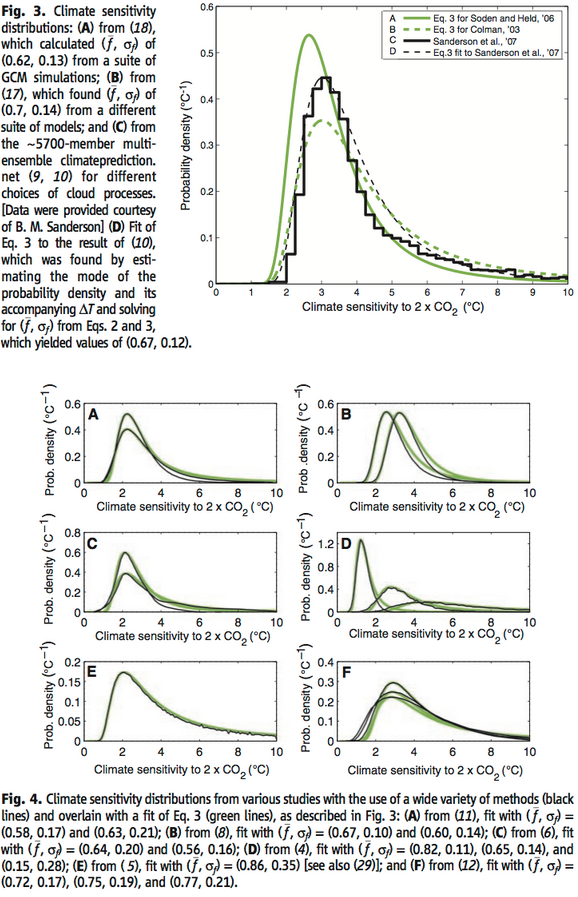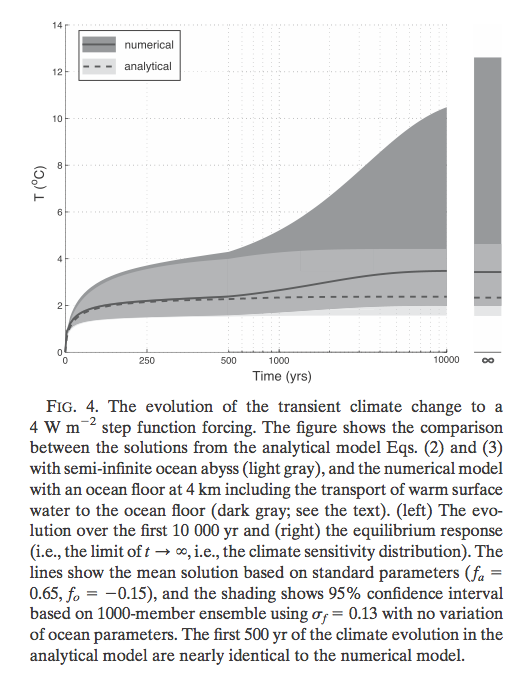In a nutshell
In our main discussion of the impacts of unmitigated climate change, we focused on summarizing the most likely outcomes according to the Intergovernmental Panel on Climate Change.1 However, the dynamics of climate change are such that low-probability, extremely harmful impacts can dominate estimates of the overall harms. Only accounting for the most likely impacts of climate change, accordingly, may lead to a significant underestimate of the total expected impacts.2 This page reviews our understanding of extreme humanitarian risks of climate change that are considered possible but unlikely, and considers interventions that may mitigate those risks. This page is one part of our broader shallow investigation of how climate change may compare to other philanthropic opportunities.
1. The problem: Risk of worse-than-expected impacts
The Intergovernmental Panel on Climate Change Fourth Assessment Report considers a global average temperature increase of 2.4-6.4ºC by 2100 to be “likely” under a high emissions scenario.3 Based on the IPCC’s technical definition of “likely,” we take this assessment to mean that the expert consensus cannot rule out a very meaningful–around 10%–chance of a global average temperature increase of more than 6.4ºC by 2100, though we understand the upper confidence limit on temperature increase to be highly uncertain.4 Such a large temperature increase may be disastrous for large populations of people.5 The risk of greater-than-expected temperature change is worth particular attention because the estimated humanitarian impacts of climate changes are highly nonlinear: marginal temperature increases are expected to cause more damage at already-increased temperatures (i.e. going from 3ºC to 4ºC is expected to be significantly worse than going from 1ºC to 2ºC). This implies that the “likely” impacts considered on our main page on the impacts of climate change–and, largely, by scientists and the IPCC–may vastly understate the true expected value of climate change harms. For instance, on the fairly common, though not necessarily well-grounded, assumption that damages from climate change are roughly proportional to the square of temperature change, a 10% risk of a 6.4ºC temperature increase would be approximately as harmful as a 100% risk of a 2ºC temperature increase.6 The humanitarian risk due to worse-than-expected climate change may be even larger than this example suggests, for two reasons:
- Uncertainty about climate sensitivity is asymmetrically distributed in a way that favors more extreme temperature changes, and potentially very extreme climate changes can’t be ruled out.7 Further observation may be unable to reduce this uncertainty much.8 However, in the event of very high climate sensitivity (i.e. a high degree of climate change for the level of carbon in the atmosphere), our understanding is that the full temperature increase will likely take centuries to occur because the oceans absorb heat at a relatively slow pace.9 Accordingly, the uncertainty in the upper tail of the climate sensitivity distribution primarily impacts expected temperatures in the distant future.
- More importantly, the damage caused by a given change in temperature is unlikely to follow precisely the hypothesized quadratic relationship, and may well be far worse than quadratic for high temperature changes.10 Modeling uncertainty and “unknown unknowns” further widen the bands of uncertainty around potential harms.11
Note: this page was drafted prior to the release of the Fifth Assessment Report of the First Working Group of the IPCC in September 2013. The Fifth Assessment Report continues to support the general conclusions reported above, though it reports a slightly narrower confidence interval for temperature change in 2100 under the highest included emissions scenario, primarily because of a change in scenario composition.12 This discussion has been limited and conceptual. Below, we review a few non-systematic examples of how damages from worse-than-expected outcomes could play an important role in an overall assessment of the harms of climate change.
1.1 Examples of low-probability, high-impact risks
Climate change could potentially trigger a number of low-probability environmental events with extremely adverse consequences to humans. One such risk is the melting of the Greenland ice sheet, leading to sea level rise and flooding.13 Our understanding, discussed on our main page on climate impacts, is that sea level rise of more than 2 meters in the 21st century is considered unlikely, and that, with adaptation, such a sea level rise is projected to displace roughly 300,000 people, while without adaptation, it is projected to displace nearly 200 million people.14 However, climate scientist James Hansen has questioned this upper limit and argued that the 21st century could see as much as five meters of sea level rise.15 We do not have a quantitative assessment of the probability of such a radical level of sea level rise, and we believe it to be widely considered unlikely, but we are not in a position to rule it out at this point. Rising temperatures could also impact human health through extreme heat waves, or cause droughts that might lead to water scarcity and decreased agricultural production.16 More extremely, we have seen it argued that a 12ºC increase in mean global temperature—which is substantially outside the range considered plausible this century—would cause at least one day each year in the territories where half of all people live today to be hot enough to exceed human metabolic limits and cause tissue damage from hyperthermia after a few hours of exposure.17 More likely, and on a shorter time-scale, climate change may have severe second-order impacts on human welfare, such as conflict over newly scarce resources or over the use of a controversial mitigation strategy such as geoengineering.18 These examples are only a few of the many possible low-probability, high-impact results of climate change that may play an important role in the overall harms of climate change.19 Since uncertainty compounds at each level from temperature changes to first-order effects to second-order effects, the overall probability that climate change will have catastrophic negative effects on human welfare is very uncertain. This uncertainty makes it hard to dismiss extreme risks on the basis of their low probability.20
2. What are possible interventions?
Reductions in greenhouse gas emissions are expected to disproportionately reduce the risk of extreme temperature increases and extreme impacts (relative to how much they reduce median estimated temperature changes), so mainstream interventions to reduce the negative impacts of climate change in general (discussed on our page on anthropogenic climate change) may be the most effective strategy for addressing extreme risks.21 A funder could also focus on efforts that are more specific to extreme risks, such as:
- Geoengineering research. Geoengineering using solar radiation management might seem more attractive under more extreme climate change, because extreme effects might be seen to justify the risks of geoengineering.22 Research on geoengineering could conceptually help policymakers make a more informed decision in an extreme situation. (See our page on geoengineering research for more.)
- Further research on extreme climate change. Additional research could help reduce uncertainty and inform mitigation or adaptation. Empirical research on the rate of ice and permafrost melting and integrated modeling of interrelated and multilevel climate change effects may be particularly promising.23 However, some climate scientists have suggested that reducing uncertainty about individual feedbacks may not appreciably reduce uncertainty about the overall impacts of climate change.24
3. Who else is working on it?
See our main page on climate change for groups working to address climate change, and our page on geoengineering research for groups working on geoengineering research. We believe that funding for research on extreme climate change comes mostly from basic science funders like the National Science Foundation, as well as from some private donors.25 However, we do not have an overall estimate of the amount of funding in this area.
4. Questions for further investigation
Our research in this area has been relatively limited, and we have yet to answer many important questions. Amongst other topics, our further research on this cause might address:
- What concrete funding opportunities exist to limit extreme risks from climate change?
- What areas of further scientific research are most likely to reduce uncertainty around extreme risks from climate change? To what extent is it possible to reduce such uncertainties?
- How much are other funders spending on various initiatives to work on extreme risks from climate change?
- How does the value of work to specifically limit extreme climate risks compare to more common efforts to limit overall climate changes?
5. Our process
We decided to look into extreme risks from climate change because our initial review of climate impacts based on the IPCC’s Fourth Assessment report mostly focused on likely outcomes of climate change, and we saw research suggesting that low-probability, severe impacts can dominate estimates of harms due to climate change.26 We read a number of papers on various aspects of extreme climate risks, particularly focusing on economic models, and spoke to three academics in the field:
- Elmar Kriegler – Senior Scientist at the Potsdam Institute for Climate Impact Research
- Kirsten Zickfeld – Assistant Professor, Simon Fraser University, Department of Geography
- Klaus Keller – Associate Professor of Geosciences, Pennsylvania State University
6. Sources
| DOCUMENT | SOURCE |
|---|---|
| Baker and Roe 2009 | Source (archive) |
| Hansen and Sato 2012 | Source (archive) |
| IPCC AR4 Synthesis Report | Source (archive) |
| IPCC AR4 WGI Chapter 10 | Source (archive) |
| IPCC AR5 WGI Chapter 12 | Source (archive) |
| IPCC AR5 WGI Summary for Policymakers | Source (archive) |
| Kelly and Tan 2013 | Source (archive) |
| Kousky et al. 2010 | Source (archive) |
| Mendelsohn 2009 | Source (archive) |
| Nicholls et al. 2011 | Source (archive) |
| Notes from a conversation with Elmar Kriegler, 4/18/2013 | Source |
| Notes from a conversation with Kirsten Zickfeld, 04/17/13 | Source |
| Notes from a conversation with Klaus Keller, 4/18/2013 | Source |
| Roe and Baker 2007 | Source (archive) |
| Roe and Bauman 2012 | Source (archive) |
| Sherwood and Huber 2010 | Source (archive) |
| Stanton, Ackerman, and Kartha 2008 | Source (archive) |
| Weitzman 2009 | Source (archive) |
| Weitzman 2012 | Source (archive) |

